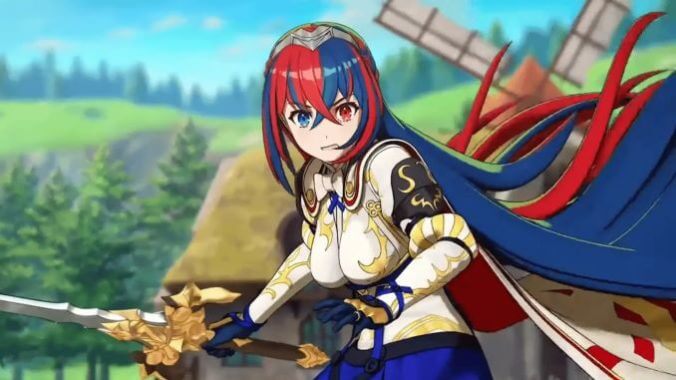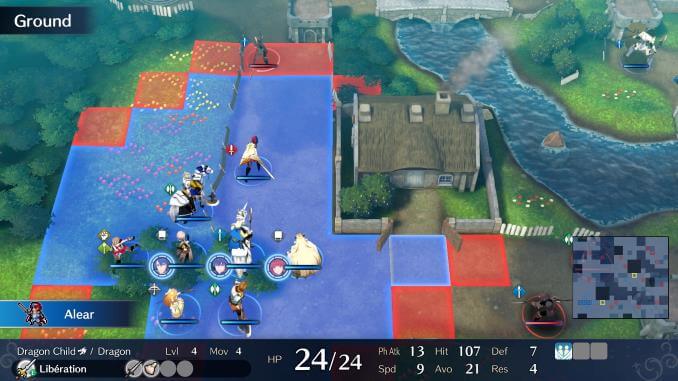
About a decade ago, the state of the Fire Emblem franchise of tactical role-playing games was in a precarious place. Its previous two entries—Fire Emblem: Shadow Dragon, a remake of the original Fire Emblem, and Fire Emblem: New Mystery of the Emblem, a remake of the original’s sequel—underperformed critically and commercially. New Mystery became the first Fire Emblem since The Blazing Blade to not receive a localization in the West. And thus, Nintendo gave Fire Emblem’s developer, Intelligent Systems, an ultimatum: if their next game failed to sell more than 250,000 copies, it would be the series’ final venture.
The issue with Fire Emblem is also one of its greatest assets. Fire Emblem is an even more acute example than Pokémon of how simple numbers and formulae can lead to a rewarding and deep gameplay loop. The simplicity of Fire Emblem’s format and progression means if a player enjoys one entry, they will inevitably enjoy most if not all of the others. Unfortunately, for Fire Emblem and Pokémon alike, it becomes difficult to embellish on this idea without feeling bloated, disconnected, or tedious. As RPGs (and, more broadly, games as a whole) have evolved over time, Fire Emblem has struggled to innovate and keep up with trends of the time.
Intelligent Systems threw many ideas at the wall, several of which would have altered the feeling and aesthetic of the series entirely, such as setting the game in the modern era, or having it take place on Mars. Instead, they landed on the game being something of a “Best Of” compilation of the series’ many gimmicks and systems, including marriage, a playable second generation, a customizable player avatar, and even characters from past entries making an appearance. The game would also include a Casual Mode to attract new players who wanted to play the game for the story, or for the matchmaking aspect of the gameplay. This game would be titled Fire Emblem: Awakening, and it would rapidly sell record numbers for the series and surpass Nintendo’s 250,000 challenge in little over a week. Elements of Awakening have since become quintessential to the series and define how it’s thought of in the mainstream—it’s a game full of quirky, lovable anime characters who you can ship together however you see fit, a convention that has grown in popularity and now become typical among RPGs.
Fire Emblem: Engage is quite similar to Awakening in its reverence for the franchise’s past, but instead of a coda, it’s a song of celebration. Engage had big shoes to fill, being the direct successor to the incredibly enduring and ambitious Three Houses. Just one playthrough of Three Houses could take upwards of 100 hours to complete, and that would leave you with three other storylines to experience. I would wager most people that love Three Houses haven’t even seen everything there is to see in it. Three Houses stands as something of a victory lap for the series, a type of game we’ve increasingly seen in the last five or so years starting with, perhaps, Breath of the Wild—-a game that’s so large and with so much breadth, you’re left wondering how it could possibly be anything but the final game in the series.
Instead of going bigger (something I struggle to imagine is possible), Engage went the opposite direction. Inspired by many of the franchise’s older entries, Engage has a single campaign that can be completed in a modest 20 or so hours with few missable units, greatly curbed social elements, a smaller hub area, and a more classic, black-and-white story. It would again include many characters from previous games, only this time they would be integral parts of the gameplay, appearing as mentor-like spirits that give your units new abilities. Initially, I found this prospect exciting. As games have had to become more and more of an event to succeed, it seemed refreshing to have a game from a major series release with less fanfare and fewer bells and whistles. Unfortunately, Engage often wrings its hands, nervous that its simple pitch might underwhelm those expecting a more bombastic experience. It tentatively asks, “you’d like it if this was included, right? After all, you liked it when we did it before.”
Engage’s most apparent gameplay trait is the aforementioned use of previous Fire Emblem protagonists as obtainable items. Imbued in Emblem Rings, these characters—like Marth, Ike, Roy, and Celica—come with unique weapons, abilities, buffs, and niches that can only be utilized by equipping them. For example, Genealogy of the Holy War’s Sigurd specializes in movement. When equipped, you receive an immediate bonus to your movement, allowing that unit to move more spaces than they otherwise would be able to. As your bond develops with Sigurd, you earn passive skills like Canter, which allows you to move again after acting, and Momentum, which grants 1+ attack for every space you moved approaching your enemy to your first hit. After you have bonded with Sigurd enough, you can permanently inherit these abilities so they can be used even when Sigurd isn’t equipped, which allows an astute level of customization.

This is an excellent idea, but also reveals one of Engage’s integral flaws. In terms of map design and win objectives, Engage is a step above Three Houses, which often reused maps. Most were quite large and did little with the terrain, avoiding bottlenecks down hallways or the necessity of defensive maneuvers. Nevertheless, Engage can easily be beaten without even using the Emblem Rings. Growth rates in the game are generous—most of my units had three to five stats increase upon each level. With the Emblem Rings equipped, many battles become perfunctory, with units doing upwards of 100 damage in a single action if used right. Along with this, the game provides many ways to give your units both permanent and temporary stat boosts, including a workout minigame that’s so tedious to get through you may as well go without the gains.
The game caps its deployment limit at 12. There are 12 Emblem Rings in the base game. As such, it seems to imply you should have a dedicated team of 12 units, each possessing one of the rings. But in doing this you create an army so powerful it can plow through every encounter in the game with extreme ease. Engage’s strongest stretch involves losing all your previously collected rings, an unexpectedly bold move that does severely limit your options and reveals the core of what makes Fire Emblem so compelling—the series is at its strongest when it curbs the number of permutations you’re allowed, forcing you to think outside of the box or craft strategies beyond barreling down the enemy’s defensive lines. Fire Emblem succeeds with less, not more.
Engage’s lack of confidence in the franchise’s gameplay echoes off the battlefield as well. Three Houses centered itself entirely around its social elements, its setting justifying the existence of these mechanics. In previous Fire Emblem games, it wouldn’t have made sense to have copious amounts of downtime, idle chatter, or recreational activities like fishing and cooking. In fact, prior to Awakening, you were limited to just five support conversations per unit, meaning you could only reach the final support conversation with one other unit. The preciousness of these conversations afforded them a certain gravity—they were bonds crafted amidst duress, clipped short because of the direness of the overarching war.
Despite Three Houses’ inclusion of an academy setting aligning with trends of the time, it managed to feel apt and even enjoyable. During the course of the school year, you watched as your students bonded, broke bread with one another, and bridged the gap between class and national lines to forge friendships that would carry over into the game’s second act, when each of the game’s three nations are pitted against each other. Memories of simpler times fueled Three Houses’s themes of peace, necessary violence, and nostalgia.
In Engage, after each battle, you’re given the option to return to the Somniel. At the Somniel, you can do many of the activities you could in Three Houses. Unlike the academy, though, the Somniel is a paradise where characters seem to forget about their current toils. Because of the incentives associated with returning after each battle (viewing supports, boosting your stats, shopping, training in the arena, and more), the linear flow of the game—contrary to Three Houses episodic, calendar-based progression—is interrupted frequently, giving the game a confused tone that teeters between a fast-paced adventure series and something closer to a silly slice-of-life anime. Both of these qualities are perfectly enjoyable on their own, but enmesh in awkward and often dissonant ways in practice. Because of the game’s lightness, you’re left with little to grapple onto, and every single support in the game comes across more as a corny joke than an attempt to illustrate a real relationship between comrades.
If Engage was more self-assured, it might remove the Somniel entirely. Here, the social gimmicks feel more like necessities, monotonous tasks you’re forced to run around and do despite their hollowness. They distract from where the game shines, which is in its gameplay, beautiful presentation, excellent music, and straightforward premise. Often, the game feels more like an advertisement for its characters, which occasionally feel more like idols or gacha units than soldiers (which is only reinforced by an actual, though disconnected, gacha system within the game). It feels disrespectful to deploy some of Fire Emblem’s shining protagonists from weightier games in an entry this light and confused, one whose main character is an empty vessel. While Engage is perfectly serviceable and even an improvement on Three Houses in some ways, I want more for a series with such a storied history—and, I imagine, so will most of its fans.
Fire Emblem: Engage was developed by Intelligent Systems and published by Nintendo. It is available for the Switch.
Austin Jones is a writer with eclectic media interests. You can chat with him about horror games, electronic music, Joanna Newsom and ‘80s-‘90s anime on Twitter @belfryfire